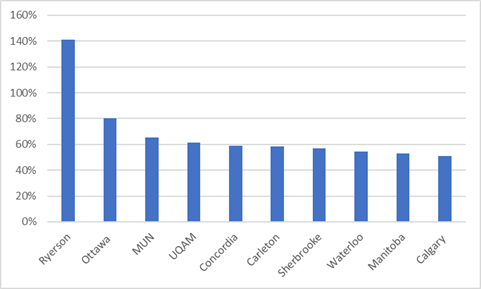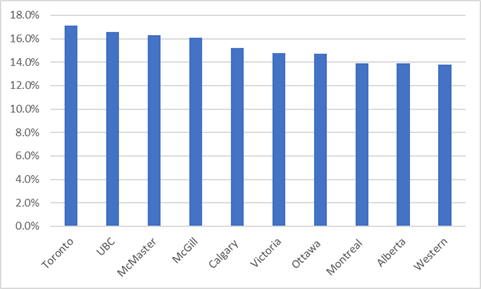Yesterday, the good folks at the Centre for Science and Technology Studies at Leiden University released their 2019 world ranking of university research output. This is – in my opinion – the best bibliometric ranking out there: it is complete, nuanced and the people putting it out have thought hard and responsibly about what it means to use quantitatively evaluate research. I thought it was time to have a quick look at the research landscape across Canada.
Let’s start with raw publication numbers across all academic fields. Figure 1 shows total publications over the most recent four years for which we have data (2014-2017). No surprise here – the University of Toronto produces by far the most publications, followed by UBC and McGill. Toronto’s publication count is over 42,000 for the four-year period using a non-fractional count (a fractional count adjusting for the number of co-authors cuts these numbers by half but does not change the order except for Western and McMaster, which change places). This put Toronto in the #2 slot in the world, behind only Harvard. This is a pretty amazing achievement, even if it is partially the product of somehow getting credit for the work of a heck of a lot of hospital-based researchers whose salaries they don’t actually pay.
Figure 1: Top Ten Canadian Institutions, Total Publications, 2014-2017

We can examine publications not just in terms of absolute output but also in terms of increase over the past decade. Overall indexed research output across the globe is increasing rapidly, due mainly to improvements in index coverage and the expansion of open access publishing. Across the top 30 Canadian institutions, the total increase in output is 48% (which is somewhat below the global average), but it is by no means distributed equally. Proportionately, the biggest increases have come mostly from non-U15 schools (presumably because they were working from a lower base), although a few already-research intensive institutions, most notably the University of Ottawa, do well. Not everyone does quite so well: Windsor, UNB and Queen’s are the bottom three in terms of improvement.
Figure 2: Percentage Increase in Indexed Publications, 2014-17 over 2006-09, Top Ten Most Improved Canadian Institutions

In addition to simple publication counts, we can also look at research impact. Leiden seems to no longer use normalized citation scores, but it does still publish several similar kinds of measures. In figure 3, we look at the percentage of papers which are among the 10% most highly cited in their respective domains. If more than 10% of the papers your profs produce make it into the top 10% of most-cited papers in the world, you are doing well, globally speaking: Canada has seven institutions where the percentage is over 14%. The top ten in impact resembles the to ten in output, with Toronto at the top and the usual suspects near the top. The exception is that Victoria punches way above its weight on this count and Waterloo doesn’t make the top ten.
Figure 3: Top Ten Canadian Universities, Percentage of Publications among 10% Most Cited in Field, 2014-2017

Again, we can look not just at top institutions but most improved institutions. And this is really interesting, because it turns out that over the past decade or so every single Canadian university has increased its share of papers in the global top-ten percent. Not always by very much (progress isn’t great at either Queen’s or York) but for the most part the gains are on the order of 1.5 percentage points (meaning if a school had a 10% share of global top 10% papers in 2006-09, they probably have about a 11.5% share now. While some of the credit for this big increase in top-rated papers goes to big research powerhouses like Toronto, some credit also goes to much less-heralded schools like Saskatchewan and Ryerson.
Figure 4: Most Improved Canadian Universities, Percentage of Publications among 10% Most Cited in Field, 2014-2017 vs, 2006-09

There you have it. Toronto, as usual, comes out tops on output and impact, followed by UBC and probably McGill (though there are a couple of others that could make a good case for third place. Ryerson and Ottawa are notable for their big improvements in outputs; Saskatchewan and Calgary come top when we look at increasing share of “most-cited” papers). But most importantly: the country as a whole is rapidly increasing its share of top-cited publications. This is a big deal, because unlike research publication numbers, share of top 10% papers is a zero-sum game: we’re getting better at this research thing faster than others. Put simply, the quality of our academic research across all fields is demonstrably improving. Whatever we’ve been doing to get there, we need to keep doing.

 Tweet this post
Tweet this post

Are these figures universal across all disciplines? It would be interesting if this data could be broken down by field of research.
Could it simply be the case that Canadians are getting better at citing one another, or joining cultish little mutual admiration societies, whose members cite one another? In other words, is this a measure of true merit, or simply of networking?
You can still find normalized citation scores (MNCS) but only if you click on the name of a university. It even has a time trend per field on MNCS.
I tried to find out but couldn’t tell whether the count is of all publications, or all publications in English. I was also curious as to how non-university research organizations (eg., government reserach organizations, corporations, NGOs) fare in comparison, but there’s no data.